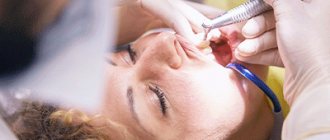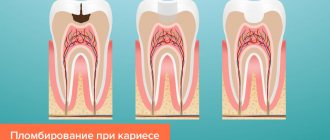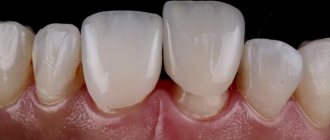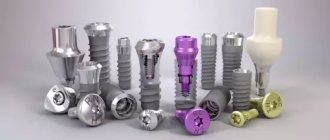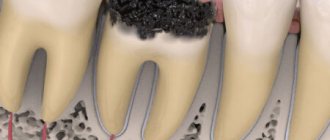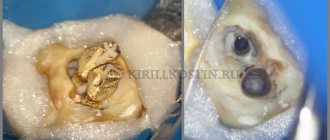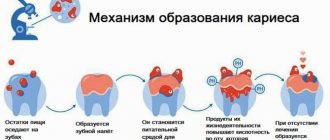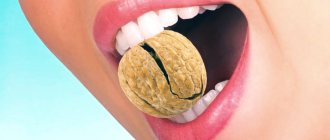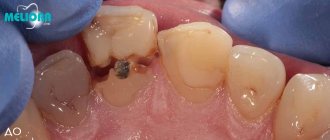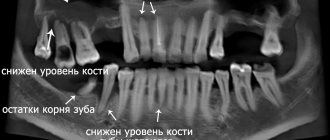The crown part of the front tooth is broken
If a front tooth is partially fractured, veneers or crowns can be used.
Veneers restore tooth function, protect dentin from external influences, and also the aesthetics of a smile. Treatment is only suitable for slightly damaged teeth. If the dental crown is severely damaged, the dentist will suggest installing a ceramic crown.
Crowns are placed on the remaining part of the tooth after grinding and preparing the surrounding area around the damaged tooth. If a significant part of the tooth has broken off, then to securely fix the crown it will be necessary to make a stump inlay, and in this case the tooth will have to be depulped (remove the nerve and fill the root canal).
The main stages of tooth restoration using a crown:
- Drawing up and agreeing on a treatment plan;
- Next, the doctor grinds the tooth down for a crown;
- Taking a silicone impression. The impression is sent to the dental laboratory. Based on the impression, the technicians reconstruct a plaster model of the teeth, and the technician will model the crown on it;
- When the crown is made, it is tried on and, if there is no discomfort, fixed on the stump.
To close the aesthetic defect, until the permanent crown is made, I install temporary plastic crowns on the patient, which can be made either in the laboratory or in the clinic.
Material for making dental crowns . Front teeth are a person’s calling card. When smiling, in conversation, every person involuntarily exposes his front teeth. Their beauty and health attract their interlocutor. This is why choosing the type of crown for teeth in the smile area is so important. The main types of permanent dental crowns are metal-ceramics, metal-free ceramics and ceramics with a zirconium dioxide frame. The most preferable material, from an aesthetic point of view, for the manufacture of dental crowns for the front teeth is metal-free ceramics e.max or feldspathic ceramics, also ceramics with a zirconium dioxide frame.
Symptoms of a tooth fracture
Injuries often go unnoticed, as a result of which the floor of a tooth that is deprived of sensitivity is broken. Also, the clinic may be absent if there is minor damage to the enamel. Such defects can only be determined visually during an independent examination of the oral cavity.
In other cases, when a tooth is fractured, a person experiences pain. A pain syndrome that limits the movement of the lower jaw occurs when a tooth breaks at the root, and the fragments injure the soft tissue of the gums. A tooth broken under the gum often causes loosening of adjacent units, bleeding and speech impairment.
Deputy Chief physician Sergey Evgenievich Brodsky
Sign up for a free consultation
+7
First aid for a fracture
When a tooth breaks and hurts, you should immediately seek help from a dentist. Before examination by a specialist, doctors at the Partner-Med clinic recommend providing first aid, namely:
- rinse your mouth with clean boiled water at room temperature or warm chamomile infusion;
- apply and firmly clamp the application with cotton wool or a bandage in case of bleeding;
- take a pain reliever with an anti-inflammatory effect (Analgin, Paracetamol, Ibuprofen) if there is severe pain;
- apply a cold compress to the sore spot;
- immobilize the jaw with a tight bandage if injury is suspected.
Complications
If the front upper or lower teeth are broken, this causes, first of all, aesthetic discomfort, as the smile changes, articulation and clarity of diction are impaired. It can often provoke the development of psychological problems and complexes. A broken chewing tooth disrupts the food processing process. Large particles of food entering the stomach lead to disruption of its functions. The development of pathological processes is accompanied by a feeling of discomfort in the abdominal area and heartburn. A broken tooth under the crown causes displacement of the prosthesis, deformation of adjacent units, or injury to the gums. There is also a danger of developing infectious and inflammatory processes as a result of the penetration of pathogenic flora into injured tooth and gum tissues.
Ask a question!
8
We'll call you back in 1 minute
Diagnostics
After visiting a dental clinic, a specialist relieves pain and conducts a visual examination of the oral cavity, during which it is possible to determine:
- degree of damage to hard dental tissues;
- dislocation of adjacent teeth;
- tissue necrosis;
- penetration of blood into the tooth cavity.
To obtain a complete clinical picture, assess the condition of the roots of a broken tooth, the degree of displacement and damage to the nerve fibers, an x-ray examination is performed. In case of severe injuries, an orthopantogram or electroodontometry is performed to determine the condition of the dental system and assess the viability of the pulp.
Restoration method – bridge prosthesis
Dental bridges got their name for their visual resemblance to a bridge - they are a structure of two crowns, between which artificial teeth are located.
Crowns are placed on your own ground teeth. The advantages of bridges are good aesthetics and reliable fixation. Dental bridges are permanent, making them very comfortable. This type of dental prosthetics requires several visits to the doctor. First, impressions are made, from which a temporary prosthesis is made in a denture laboratory or clinic - the patient will not experience discomfort when communicating due to the absence of a front tooth. At the same time, the dental clinic prepares the supporting teeth. They are ground to install a crown to a shape that is optimally suitable for this, and most often (but not always) they are depulped. After the grinding is completed, impressions are taken again, from which dentists make a permanent prosthesis, and after that it is installed on the supporting teeth and fixed with cement.
The main disadvantage of a bridge is the need for depulpation and grinding of healthy supporting teeth. In addition, its installation, which leads to an uneven load on the alveolar bone and its thinning in the area of the missing tooth..
Why do chips appear on teeth?
Enamel is a durable transparent fabric. It reliably protects the tooth from destruction. However, there are a number of reasons why it may still break:
- eating too hard food
- mechanical injury (fall, blow)
- damage (cracks) in the enamel
- malocclusion
- untreated caries or incorrectly installed filling
- hypertonicity of the masticatory muscles
- partial absence of teeth, due to which the remaining ones are heavily overloaded
If a piece of a tooth breaks off, you need to seek help from a dentist, because over time, even a small chip can grow larger. The doctor will restore the beauty of your smile and comfortable eating, relieve psychological discomfort and increased sensitivity of teeth.
Restoration method - one-stage implantation immediately after root removal
Single-stage implantation of a front tooth involves immediately installing an implant into the socket after tooth extraction. For this type of implantation, special dental implants with aggressive threading and a high degree of primary stabilization are used. On the same day, immediately after implantation, a temporary plastic crown is installed. This implantation allows you to solve two problems - removing a broken tooth root and closing a cosmetic defect. In addition, the method allows you to save a little, because... Some manipulations are not performed (for example, the gum former is not installed).
After 3-4 months, when osseointegration of the implant is complete, permanent crowns are installed. Just as in the case of conventional crowns, from an aesthetic point of view, the best solution for the front teeth is the use of ceramic crowns and, accordingly, abutments. It is preferable to install the crown on a zirconium dioxide abutment, then in any type of lighting the crown will not stand out from the general row of teeth. In our opinion, this option for restoring a broken front tooth is the most optimal.
Damage to baby teeth
Has your child chipped a tooth? It’s not surprising, because children are very active, they often fall or hit themselves. As a result, the baby tooth may be damaged. Despite the fact that it is temporary, it also needs to be restored, because the health of the permanent teeth, as well as the correct formation of the bite, depends on the condition of the baby teeth.
What to do if a tooth chips? Disinfect your child's mouth and go to the pediatric dentist. He will apply a special gel and prescribe treatment. Typically, a baby tooth is restored with a filling.
Treatment of a broken or fractured tooth
Even a small chipped tooth can lead to a more serious problem if left untreated. Your dentist can perform a full examination and take x-rays to assess the extent of the damage and determine the correct course of treatment.
- Polishing and Bonding Dentists can sometimes repair small chips or cracks by buffing the surface. They may apply bonding agent to fill in some gaps and then polish more to get the desired shape. It may even be possible to restore pieces of broken teeth.
- Fillings and Root Canals When a crack extends beyond the surface of the tooth, more detailed work is required. Sometimes the dentist can simply place a filling, but if the crack reaches the pulp, a root canal will be required.
- Surgery and extraction Some cases can be more complex, especially with a molar fracture. Since molars have multiple roots, it is possible that the fracture only affected one. In such cases, the dentist may perform a root amputation, known as a hemisection, and save the remaining portion of the tooth.
Unfortunately, sometimes removing a broken tooth is the only solution. Tooth extraction is most often done when the fracture extends beyond the gum line or when you have a chipped tooth. Typically, a dentist will suggest a dental implant to replace a missing tooth.
Indications and contraindications for tooth augmentation
Teeth augmentation is a multi-stage technology for restoring the aesthetic appearance and functions of the jaw, which was susceptible to chipping or erased as a result of increased tone of the masticatory muscles, called buxism.
Indications for the tooth augmentation procedure:
- chips resulting from injuries;
- numerous caries lesions;
- large distance between teeth;
- wedge-shaped defect;
- the presence of a gap between the two front teeth;
- congenital structural pathologies;
- thinning and demineralization of enamel due to consumption of junk food and lack of oral hygiene;
- cervical caries;
- the presence of errors in previous dental sessions that resulted in the destruction of healthy tissue;
- malocclusion.
Having asked the dentist a question about what tooth extension is called, the patient will immediately hear the answer. The procedure is called dentition restoration. Modern extension technologies make it possible to restore the structure in most cases without resorting to its removal. The procedure is harmless, but has a number of contraindications:
- patient age – more than 60 years;
- children's age when using pins;
- presence of a cyst;
- inflammation of the gums;
- pregnancy in the first or third trimester;
- failure to comply with personal hygiene rules;
- periodontitis and stomatitis;
- jaw fracture and other injuries.
If a patient is diagnosed with diseases that are contraindications, the dentist first treats them, and then restores the dentition.
How to restore a damaged tooth?
Treatment of a damaged tooth involves the following steps:
- examination by a dentist and assessment of further “future” damaged teeth;
- restoration of the stump area using a pin or inlay. The dentist treats the canals, strengthens the unit from the inside, thereby providing reliable support for the filling;
- The crown is built up using a composite material. If the work is done efficiently, the tooth can be visually almost indistinguishable from a natural one. The dentist repeats the shape, color and even transparency.
Teeth extension methods
There are 2 main extension methods:
- Straight. Used if tooth decay is up to 30%. During the procedure, composite or photopolymer materials are used to build teeth. The former are less durable and harden after 30 minutes. The latter have a service life of 10 years and remain plastic until exposed to the lamp.
- Indirect. Applicable when damage affects no more than 70% of the structure. The method has several stages, including taking impressions, making and installing ceramic inlays.
If you have ever thought about whether a crown or extension is better, then you should know that a crown is installed when more than 70% of the tissue is destroyed, but a intact and healthy root remains.

